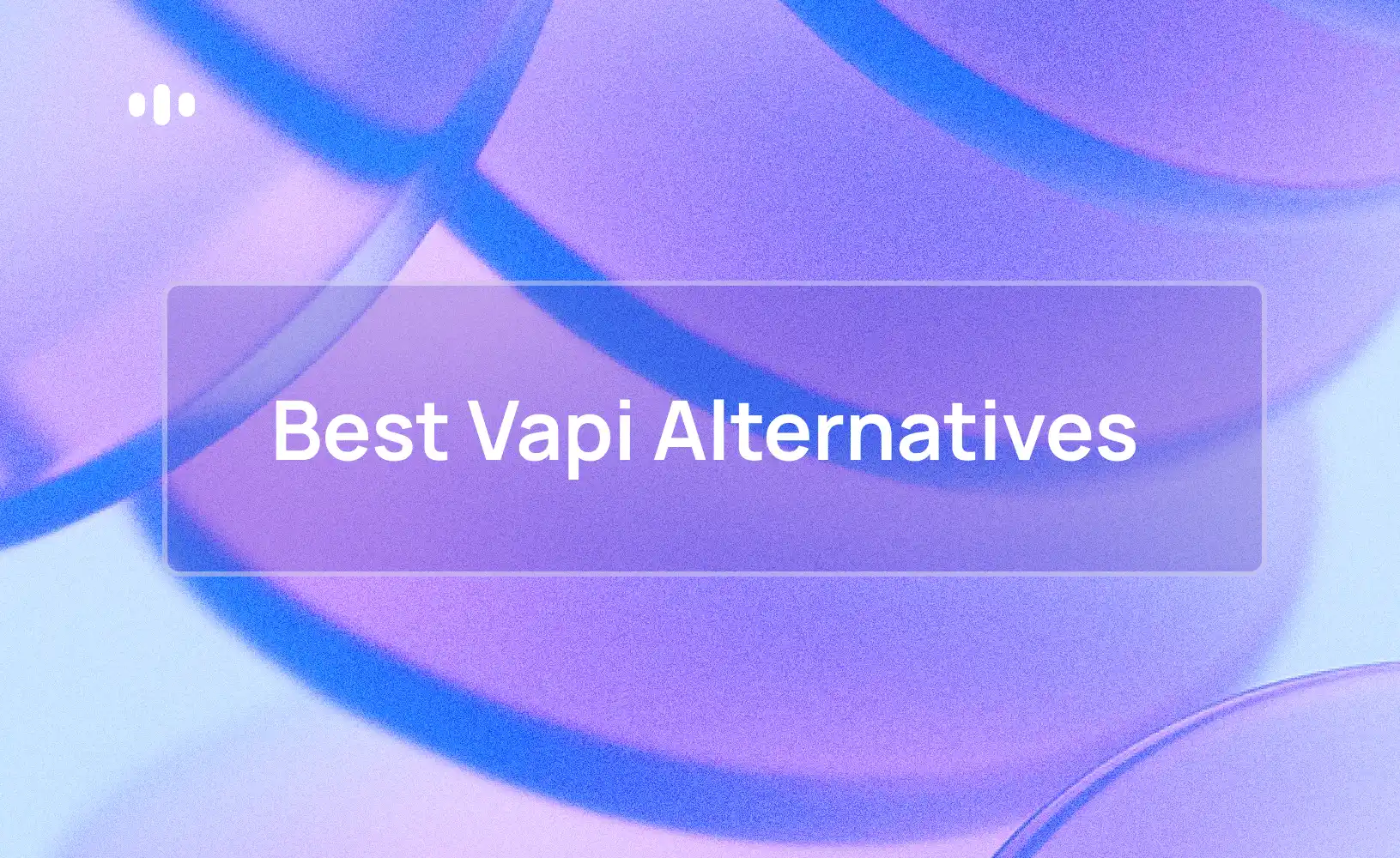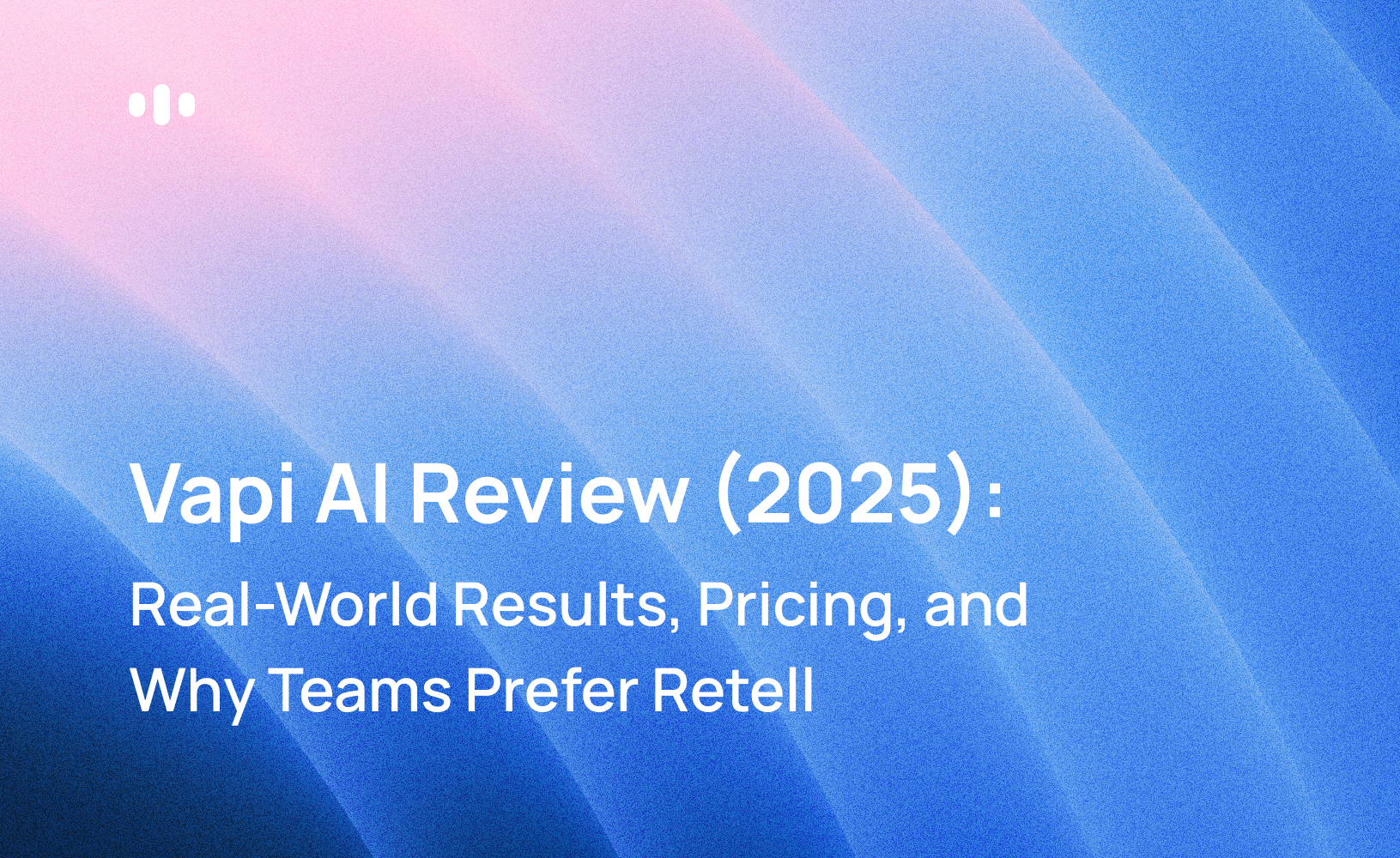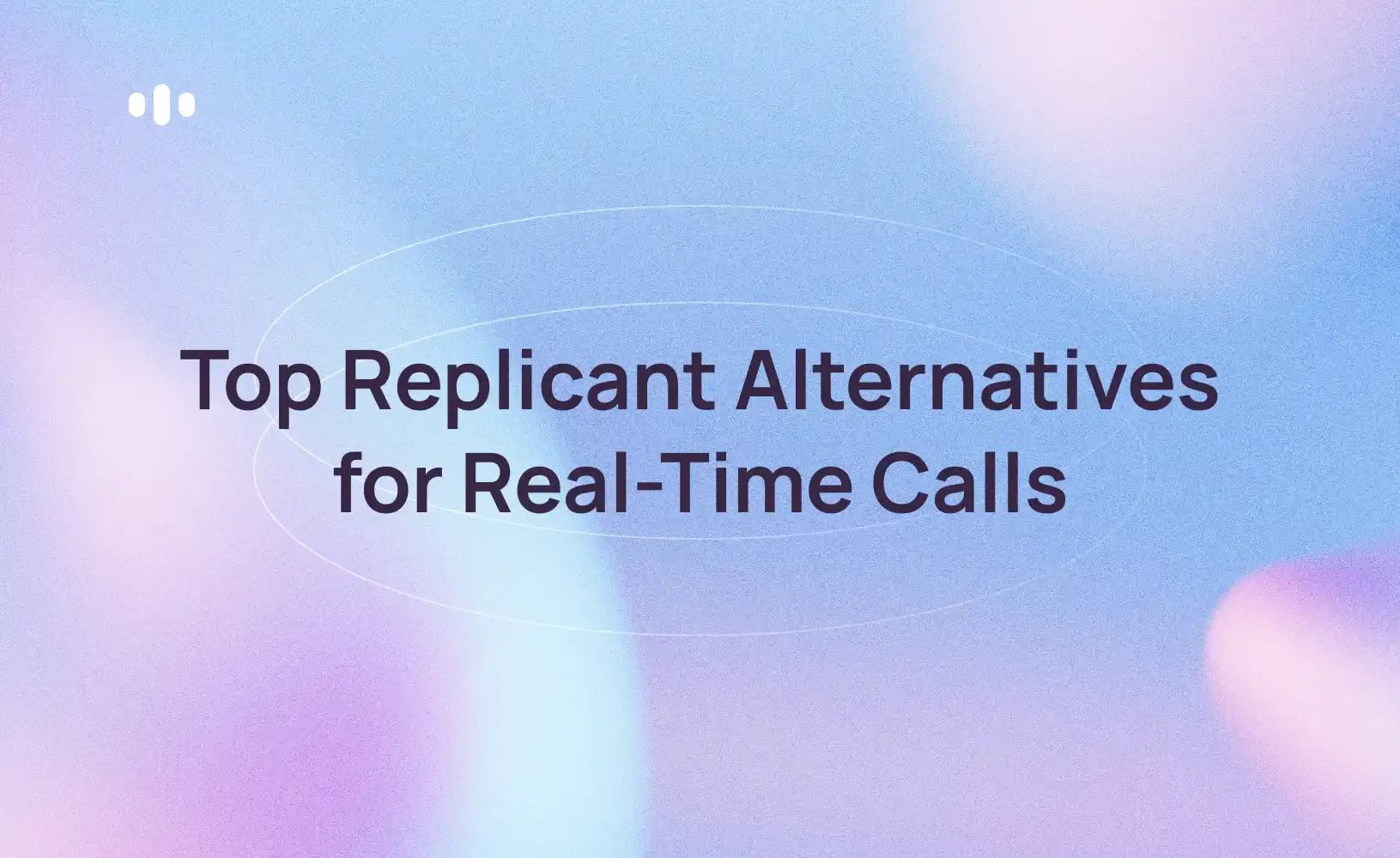Tools like Vapi can give teams a huge head start with voice AI. They make it simple to get a basic call flow running for lead qualification, appointment booking, or simple customer support.
But here’s the thing: that initial simplicity often becomes a liability. As soon as a company’s needs get a little more complex, the Vapi model starts to break down.
That’s why I’ve been digging into alternatives. Each one has its own angle. Some are built for teams with zero coding experience, others are all about deep analytics, and a few are designed from the ground up for the heavy demands of mission-critical industries.
In this article, I’m going to walk you through what really matters when you’re vetting a voice AI platform in 2025. I’ll lay out the criteria and point you to the Vapi alternatives that are actually delivering today.
At its core, Vapi is a developer-centric solution for building voice experiences powered by AI. Vapi provides infrastructure for building voice AI applications and AI phone systems, enabling seamless integration, customization, and scalability.
Businesses use Vapi to automate their phone operations, where AI-powered assistants can answer questions, qualify leads, schedule appointments, and perform repetitive customer interactions in real time.
Vapi’s UI makes it accessible to marketers and ops teams, not just programmers, so organizations of any size, from startups to enterprises, can launch voice AI projects and rapidly deploy voice applications for various business needs without heavy developer support.
Here’s a breakdown of Vapi’s main limitations, highlighting key areas where it may fall short for B2B buyers.
• Technical Complexity: Non-technical users may face a learning curve for setup, advanced configuration, and integration with APIs or external apps.
• Limited Functionality Outside Calls: Vapi is focused exclusively on phone calls. It does not natively support other channels (like email or chat), nor does it manage multi-modal customer interactions.
• Confusing Pricing Structure: While Vapi advertises competitive per-minute rates, additional costs for AI models, speech tools, and the rest of the required integrations means budgeting can be difficult for some teams. Pricing is often based on connected calls, so costs can add up quickly during active sessions.
• Latency and Voice Quality Variability: Voice quality and response times can differ across speech providers, regions, and setups, especially when relying on the public internet. This sometimes results in robotic voices or unnatural pauses that detract from the user experience.
• Concurrency and Scaling Limits: By default, there may be restrictions on the number of connected calls an account can handle, potentially limiting scalability for high-volume operations.
• Outbound Campaign Management: While Vapi excels at inbound agent setup, managing outbound campaigns, contact segmentation, and CRM integration often needs custom development.
• Limited Analytics and Monitoring: Vapi’s lack of detailed call logs can make debugging, post-call analysis, and quality assurance more challenging, which means teams may struggle to optimize AI performance or integrate interaction data into broader systems.
From our perspective, for B2B teams evaluating Vapi, it remains a robust solution for automating routine phone tasks. But one thing is clear: it isn’t an all-in-one customer engagement suite.
This is precisely why I believe the market has seen a surge in Vapi alternatives, with each one addressing different pain points around usability, scalability, integration, and total cost of ownership.
When evaluating voice AI platforms for large-scale industries, such as Healthcare, Financial Services, Insurance, or Logistics, the stakes for operational excellence are especially high. Exploring and selecting the right platform depends on your business needs, as aligning solutions with organizational requirements, technical capabilities, and budget constraints ensures optimal performance and integration.
Here are the key factors I consider when exploring and selecting a voice AI platform:
• Ease of Use vs. Technical Control: Some platforms are great no-code options for teams without technical resources. However, if you’re a developer seeking deep customization, I’d point you toward tools like Retell or PolyAI. Product teams may prioritize intuitive interfaces, while developers might focus on flexibility and control.
• Pricing Transparency and Support: I always recommend looking for a solution with clear, usage-based pricing to avoid surprises. Retell, for instance, is known for its modular pricing with no platform fees, whereas some enterprise platforms have custom pricing models that can become costly. Access to robust developer resources, such as documentation and support, is also valuable for long-term success.
• Industry Compliance and Security: For highly regulated sectors, this is non-negotiable. You must prioritize vendors offering strong compliance guarantees for regulations like HIPAA, GDPR, SOC 2, or PII Redaction. This is especially crucial when handling sensitive patients or financial information.
• Multi-Channel Support: If your goal is to engage customers across voice, SMS, and email, you’d need unified channels, which is a significant advantage over voice-only solutions.
• Scalability and Concurrency: For large enterprises, verifying concurrency limits and infrastructure robustness is vital. In my experience, this is where enterprise-grade platforms truly differentiate themselves. These features matter for enterprise users who require reliable performance at scale.
• Analytics and Conversation Insights: Beyond just automation, the ability to get sentiment analysis and real-time insights is a game-changer. It helps optimize customer interactions and provides a much deeper understanding of your call performance. These analytics matter because they drive continuous improvement and measurable business outcomes.
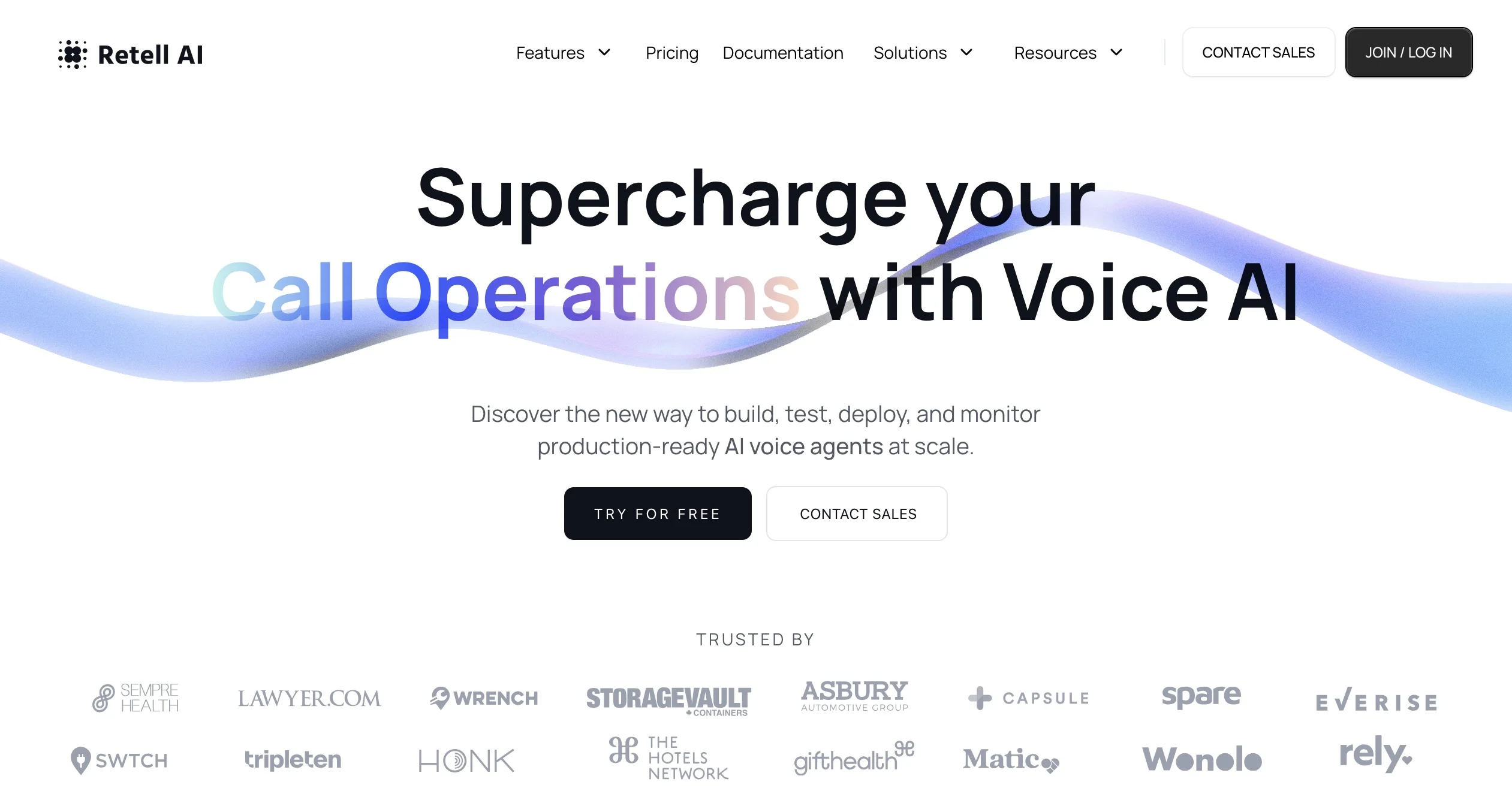
Retell AI is one of the top alternatives to Vapi, and is considered among the leading platforms for building AI voice agents. Exploring these options can help you find the best fit for your needs, whether you prioritize advanced features, performance, or the cheapest solution for specific use cases.
Retell offers a developer-friendly platform with a drag-and-drop interface for quickly building, deploying, and monitoring AI voice agents. It supports advanced LLMs, multilingual voice models, real-time workflows, and integrations with telephony providers like Twilio. These features can help expand your reach by supporting multiple languages and broader user engagement.
For a clear overview, see the table below summarizing key features and use cases of each alternative, including cost-effective options and their benefits. Retell also includes pre-built templates for common use cases like lead qualification, appointment booking, and customer support.
Retell AI excels in areas like low-code infrastructure, rapid deployment, and easy integration, making it stand out for teams looking to quickly implement voice AI solutions.
Retell is among the cheapest options for enterprise-grade voice AI. Pay-as-you-go starts at $0.07+ per minute, with volume discounts down to $0.05/min for enterprise plans. You are charged only for connected calls, not for idle time. The base price covers core voice AI services, while the rest of the costs include telephony and advanced large language models. Free $10 credit and limited concurrent calls are included for testing.
Number rental is only $2 per month, and toll-free numbers are only $5 per month.
G2 Rating: 4.8/5 (612 reviews)
Review: “Retell AI has completely transformed the way we manage automated calls, with impressive voice quality and understanding”.
Product teams and enterprises seeking a scalable, flexible voice AI platform that can be tailored to specific business needs, with transparent pricing, especially those focused on call center and outbound sales automation.
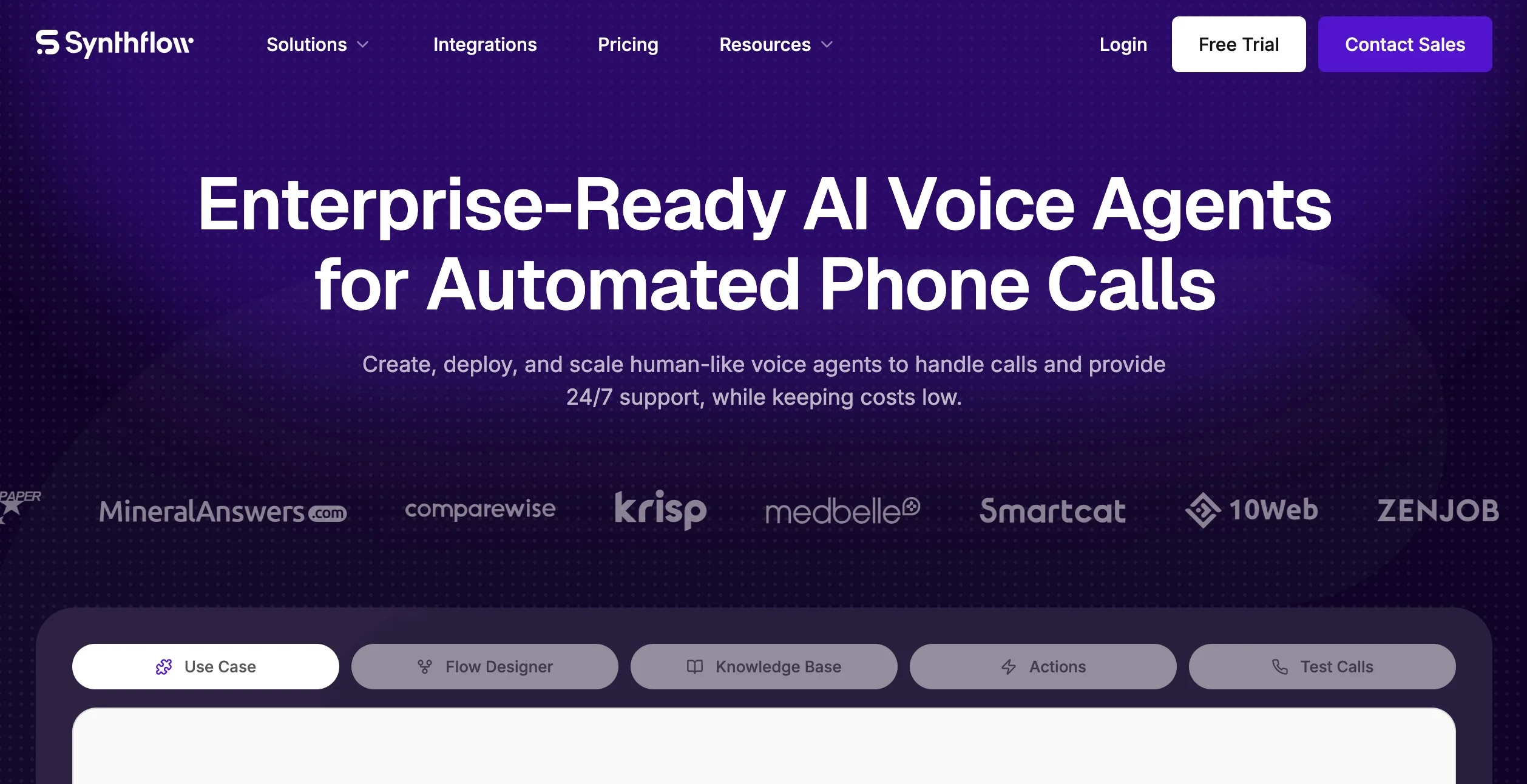
Synthflow is a scalable voice AI with a no-code visual workflow builder, real-time personalization, and deep CRM integrations. Supports HIPAA compliance, inbound routing, and multi-tenant management for agencies. Designed for production-grade voice automation.
Here’s a breakdown of Synthflow's pricing:
The starter plan is one of the cheapest options for entry-level users, starting at $29/month for 5,000 minutes and 1 agent. The Growth plan at $99/month includes 20,000 minutes and unlimited agents. The Scale plan at $249/month supports 60,000 minutes. Custom enterprise pricing is also available.
G2 Rating: 4.5/5 (815 reviews)
Review: “What I like best about Synthflow is that it doesn’t bury you in technical complexity. You don’t need to be a coder or spend weeks wiring together APIs just to get a usable AI voice agent”.
Marketing teams and enterprises with specific business needs in compliance and automation, as well as those requiring robust inbound support automation and deep integrations.

PolyAI specializes in multilingual customer support and call deflection. Integrates with major CRMs and contact center systems, and provides advanced voice customization, deep analytics, and rapid deployment.
Custom pricing with high entry thresholds (starting near $150K/year). While pricing is usage-based, it is not publicly disclosed, and PolyAI is not among the cheapest options available. More affordable or cheapest alternatives may exist, especially for those seeking lower-cost or transparent pricing models.
G2 Rating: 5/5 (11 reviews)
Review: “There are many options for AI currently in the market. PolyAI impressed us by providing a product that could be launched in a short amount of time without risking quality”.
Large enterprises and contact centers needing fully managed, custom voice AI solutions with top-tier language capabilities and complex business needs.
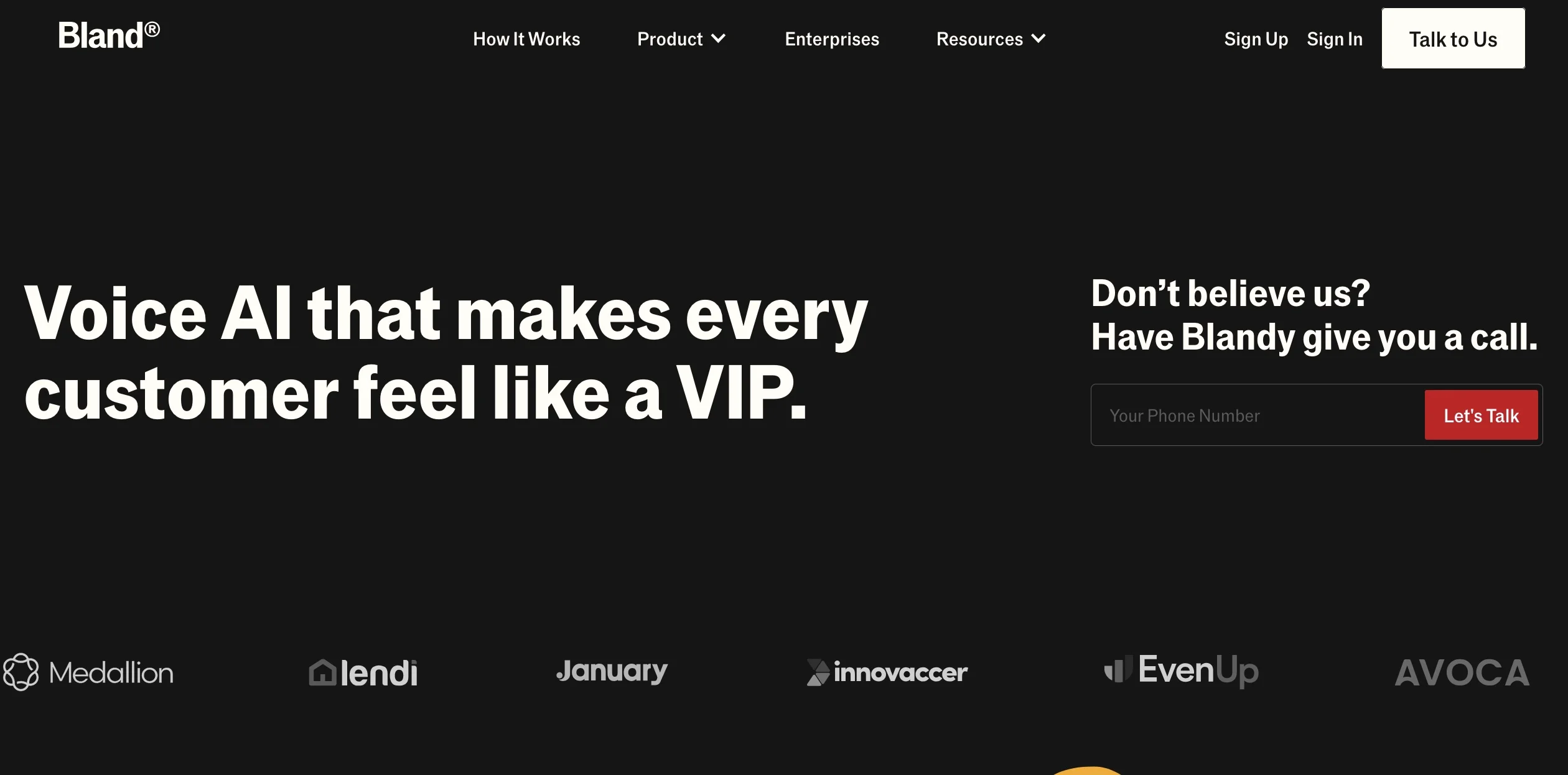
Bland emphasizes hyper-realistic voice experiences with strong security and data governance. It supports high-volume inbound and outbound calling, SMS, and omnichannel workflows. Bland markets itself as capable of scaling up to one million concurrent calls, making it attractive to enterprises that demand resiliency.
No public pricing. Bland generally positions itself at the enterprise tier, so it is not among the cheapest options available. Its costs reflect its scale and customization focus.
Product Hunt Rating: 3/5 (10 reviews)
Large enterprises with strict business needs for privacy, governance, and brand voice customization at scale.
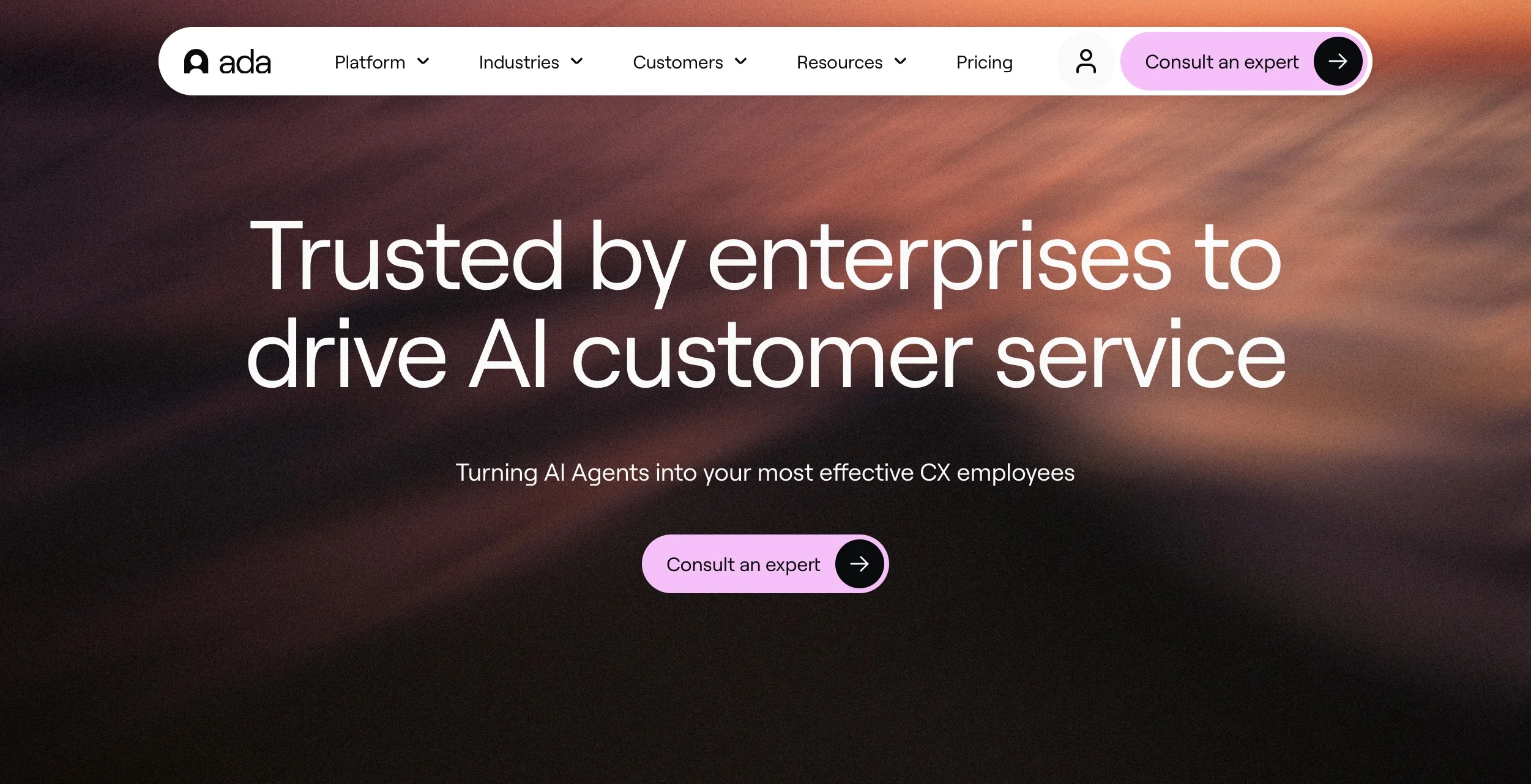
Ada.cx powers AI agents that automate customer service across chat, voice, and email, helping support teams handle complex requests at scale.
Unlike traditional bots that rely on rigid scripts, Ada’s platform was built “AI-first”, meaning its agents can understand intent, trigger workflows, and even escalate to humans when needed, all while maintaining a consistent brand tone.
G2 Rating: 4.6/5 (155 reviews)
Review: “Ada helped our small support team contain the most easy-to-resolve customer inquiries, freeing-up more time for agents to go through our backlog.”
Ada uses a performance-based pricing model, where companies pay based on successful resolutions or interaction volume rather than flat usage fees. Exact pricing depends on the number of monthly conversations, integrations, and deployment channels, but most enterprise plans start in the low six figures annually. While Ada offers robust features, it is not among the cheapest options available; other platforms may provide more affordable or budget-friendly pricing models.
Brands that prioritize customer experience at scale, especially e-commerce, fintech, and telecom companies, where multilingual support and fast automation setup are key, will find Ada ideal for addressing specific business needs in customer experience and automation.

Sierra AI deploys advanced AI agents for customer service that are uniquely trained to align with a company’s specific brand identity.
These agents can reason, predict, and take action not just based on a knowledge base, but also by adhering to the company’s tone, values, and policies for a highly personalized interaction.
G2 Rating: 4.3/5 (12 reviews)
Review: “User friendly, fast and many supported languages. Very complex setup process and more bugs then competitors”.
Sierra’s pricing begins at approximately $150,000 annually, which means it is not the cheapest option available, but it is a more cost-effective alternative for sophisticated AI compared to some higher-priced competitors.
Final pricing is customized based on agent complexity and expected interaction volume. This structure provides a lower total cost of ownership compared to Kore.ai while delivering powerful, brand-aligned automation.
Customer-centric brands where a consistent voice and adherence to company policy are critical, especially in telecommunications and financial services managing diverse customer segments and specific business needs in customer service and policy adherence.
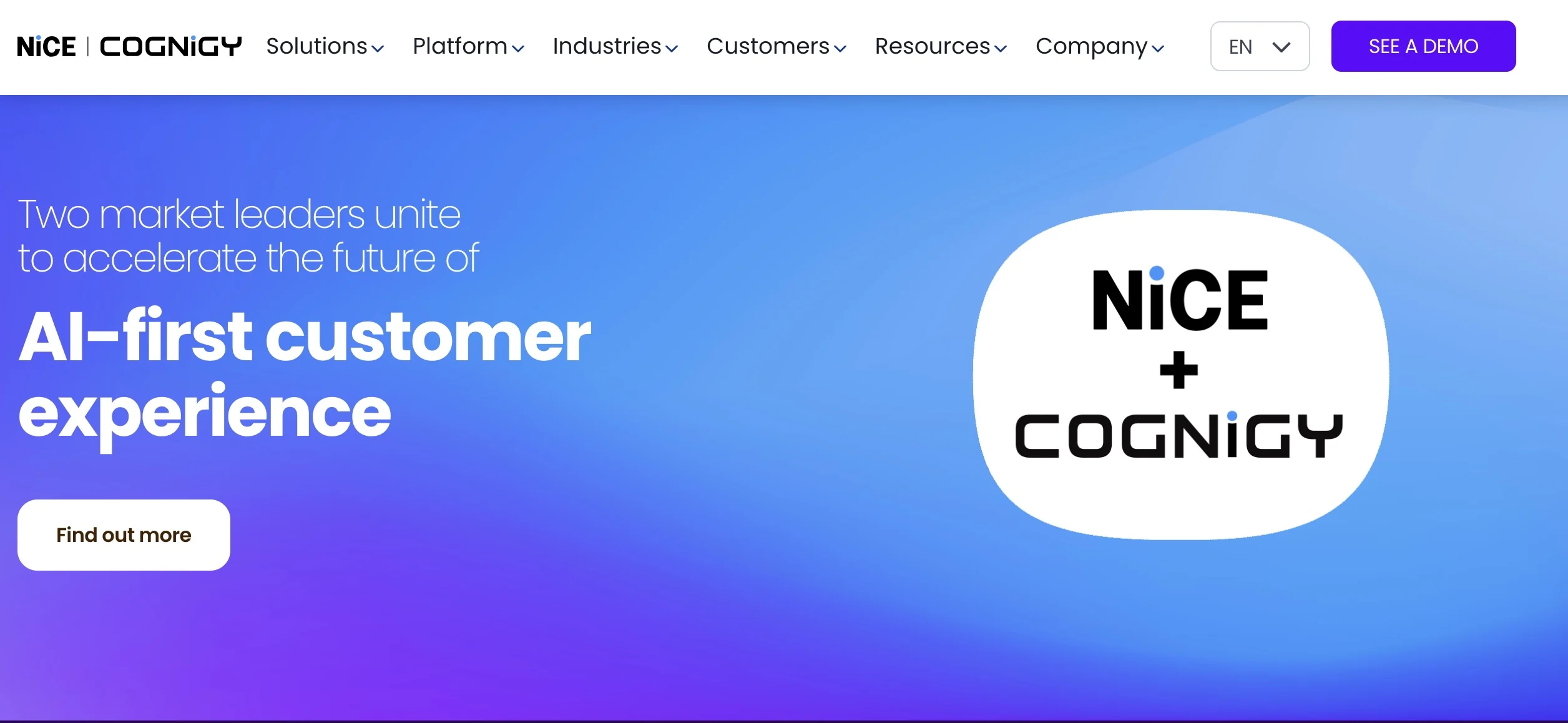
Cognigy is a conversational automation platform built for complex, enterprise-grade deployments.
It supports voice and chat channels, advanced orchestration, multilingual interactions, and customizable workflows, making it a flexible option for multinational organizations.
Enterprise licensing, typically customized to deployment scale and channel usage. Pricing is not publicly listed, and Cognigy is generally not considered among the cheapest options compared to other platforms.
G2 Rating: 4.6/5 (13 reviews)
Review: “Overall I loved it but I must mention that it does not support an extensive workflow”.
Global enterprises with complex workflows, multiple channels, and specific business needs for deep orchestration across languages and regions will find Cognigy ideal.
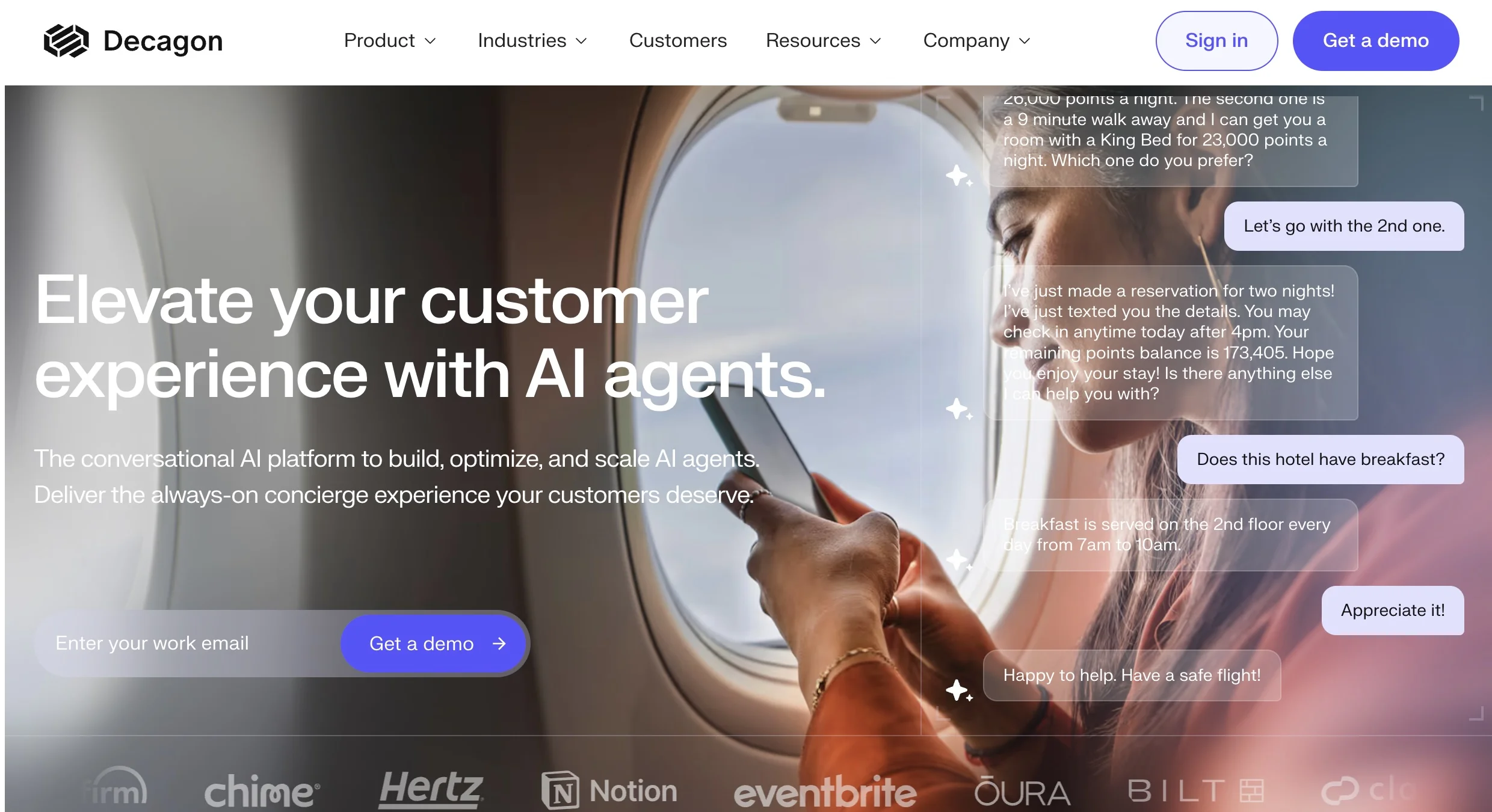
Decagon.ai offers a unified AI engine that auto-resolves customer issues across chat, voice, email, SMS, and custom channels in any language.
Their approach centers on Agent Operating Procedures (AOPs): natural-language instructions that compile into logic, allowing teams to tweak behavior without heavy coding.
Decagon frames pricing around value. Their two main tiers are:
Decagon is not among the cheapest options on the market. Because Decagon is aimed at enterprise clients with large volumes, their base pricing is custom. In one public review, estimated ranges span $95,000 to $590,900+ per year, depending on complexity, volume, and integrations. Competitors may offer more affordable or cheapest pricing models, especially for smaller businesses or those seeking lower-cost solutions.
G2 Rating: 4.9/5 (18 reviews)
Review: “The biggest upside of using Decagon isn’t simply the assumption of repetitive day-to-day tasks that would normally be done manually, but that Decagon allows us to evaluate data on a much deeper level.”
Organizations that demand high customization, transparency, and outcome-driven automation—especially in sectors like fintech, telecom, or SaaS with large support loads—will find Decagon suitable for aligning with their specific business needs. Decagon is recommended for those who require solutions tailored to their organizational requirements, technical capabilities, and integration within existing workflows.
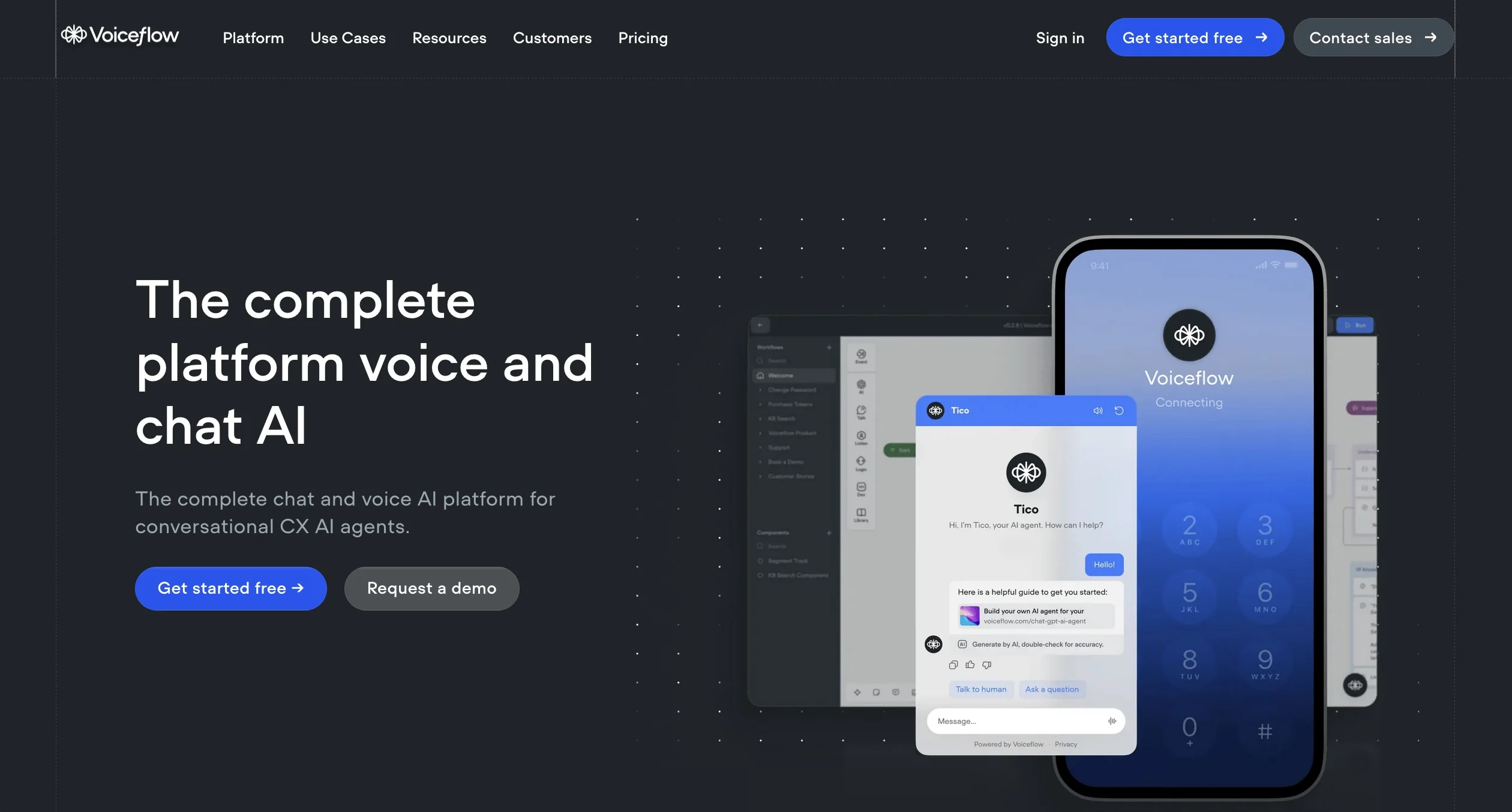
Voiceflow is a leading no-code platform for designing conversational workflows across both voice and chat.
It excels in prototyping and collaboration, allowing teams to co-design flows, manage knowledge bases, and test experiences before launch.
Voiceflow offers a free plan for basic usage. However, it is not the cheapest option available, its Pro plan starts at $60 per editor/month for up to 20 agents, while the Business plan at $150 per editor/month supports unlimited agents. Enterprise pricing is available on request, and competitors may offer more affordable or cheaper pricing models.
G2 Rating: 4.6/5 (58 reviews)
Review: “Good platform if you have less than 5,000 chats per month, otherwise extremely expensive”.
Startups, design teams, and innovators building prototypes or multichannel bots where iteration speed and alignment with specific business needs—such as rapid prototyping and multichannel deployment—are more important than call concurrency.
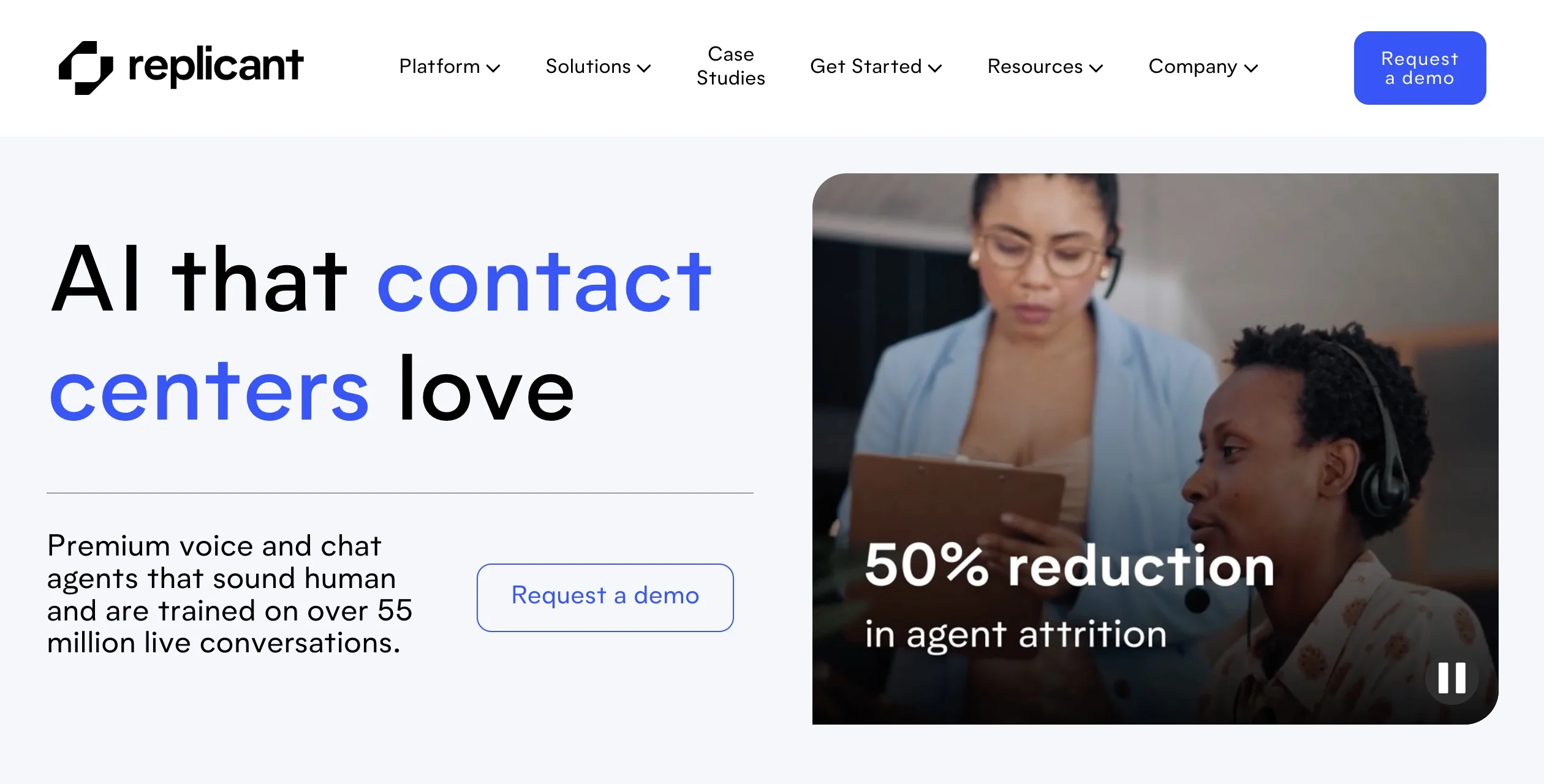
Replicant is an enterprise-grade automation platform for contact centers.
Its “Thinking Machine” resolves Tier-1 customer calls autonomously, escalates to live agents when needed, and integrates with backend systems to complete workflows. The platform includes analytics and conversation intelligence tools for optimizing performance at scale.
Replicant does not publish pricing publicly. Engagements are structured as enterprise contracts, tailored to call volumes and complexity. As a result, Replicant is generally not considered among the cheapest options, especially compared to platforms that offer transparent or pay-per-minute pricing.
G2 Rating: 4.7/5 (45 reviews)
Review: “The team is quick to reply if there are any technical concerns and is open to feedback. They usually respond within an hour when a ticket is sent in”.
Large-scale contact centers that want to automate high call volumes end-to-end, and have specific business needs in automation and scalability, with the support of an established vendor in the voice automation space.
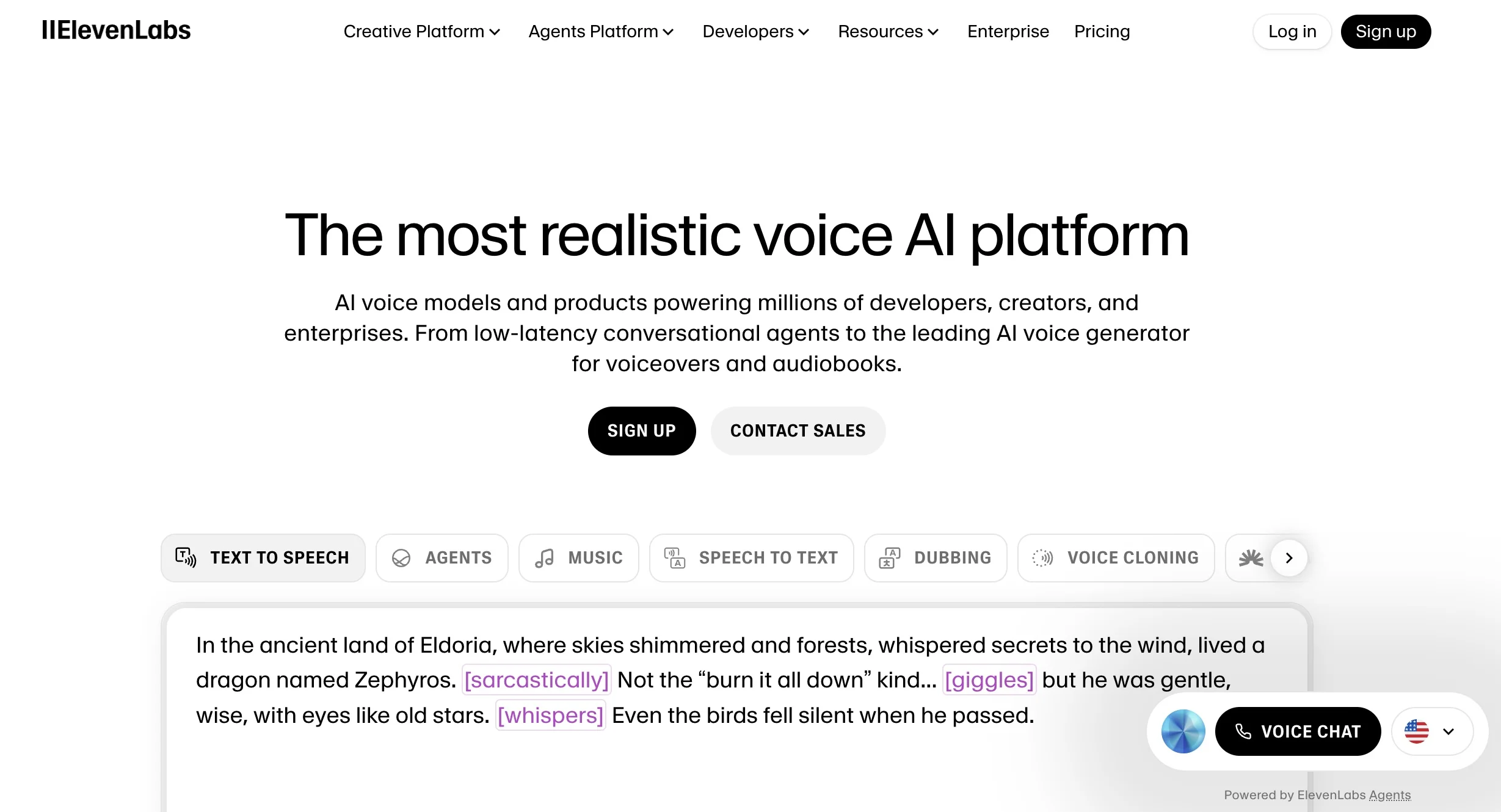
ElevenLabs is best known for its world-class text-to-speech and voice cloning tech, and more recently it’s expanded into conversational AI agents. Their platform can take user input (voice or text), ground it in your data, and produce natural spoken replies.
It’s not yet a full-blown telephony agent system, but it bridges content and voice interaction nicely, especially for brands already working in audio, narration, or voice experiences.
ElevenLabs uses a credit system. You get a bundle of credits (usable for TTS, agents, etc.), and if you exceed them, you buy more.
Example tiers (as of now):
Because it’s usage-based, your total cost will depend heavily on how many agent minutes you use, how much audio you generate, and how premium the voices are.
If your product or brand already has a voice or audio focus (podcasts, narration, gaming, or voice apps) and you want to layer in conversational agents, ElevenLabs is a powerful pick. It’s especially strong when you care deeply about sound quality, expressiveness, and voice branding. But if your priority is full telephony integration, call switching, deep voice workflows, or super predictable pricing, Vapi (or others) might still lead in those domains.
Retell is built for scale without the headaches of old-school voice tech and stands out as one of the top alternatives and leading platforms in the voice AI space.
It gives teams an enterprise-ready platform that’s powerful, but still easy to use. The drag-and-drop builder makes setup fast, while advanced large language model support and multilingual voices keep things flexible for real world applications such as customer service, healthcare, and automation workflows.
Retell is perfect for enterprises seeking scalable solutions, offering simple and transparent pricing starting at just $0.07 per minute with discounts for higher volumes. You can also rent numbers affordably and plug them straight into popular telephony providers, so deployment feels seamless and helps expand your reach through multilingual and flexible deployment options.
And while the platform is no-code friendly, developers don’t lose out: you can still build complex workflows, track live analytics, and keep full control.
For enterprises that want a scalable, no-nonsense voice AI without hidden fees or over-engineering, Retell often ends up being the go-to choice when comparing Vapi alternatives.
See how much your business could save by switching to AI-powered voice agents.
Total Human Agent Cost
AI Agent Cost
Estimated Savings
A Demo Phone Number From Retell Clinic Office
Revolutionize your call operation with Retell.
